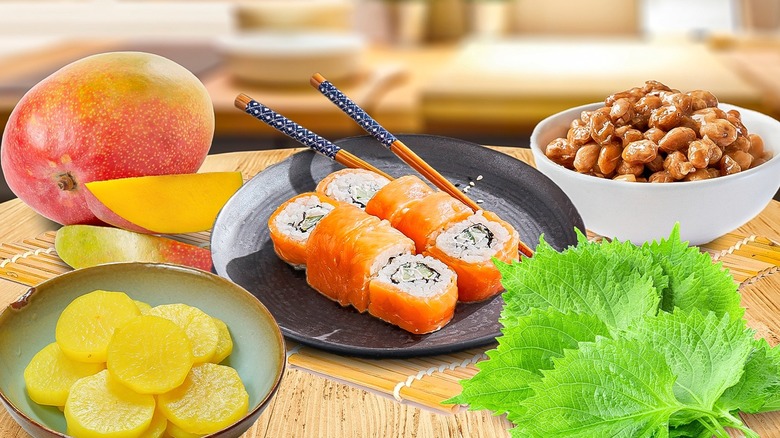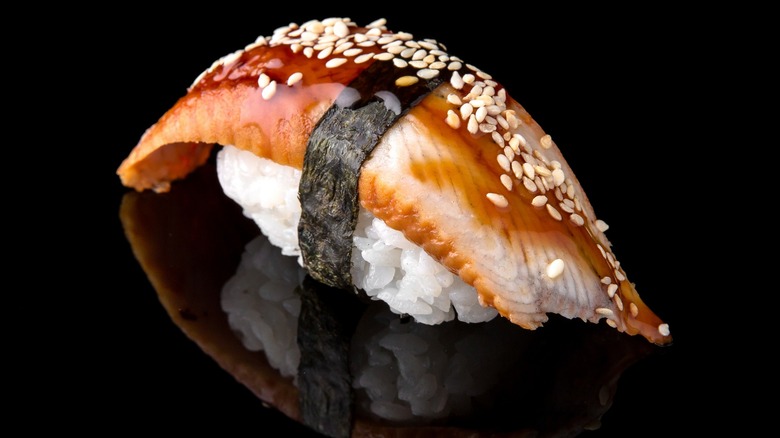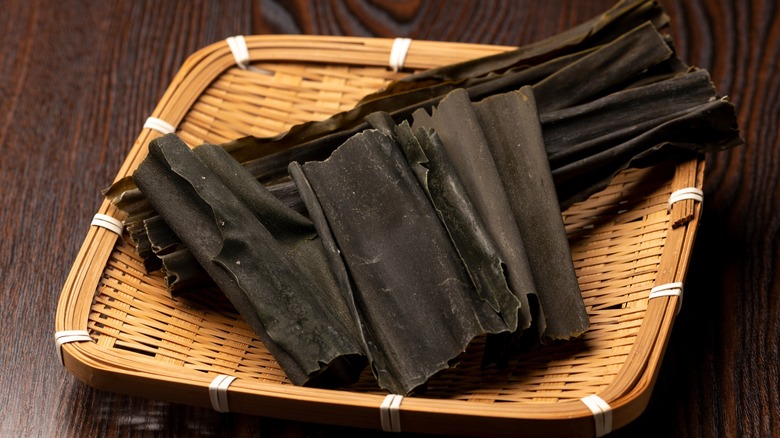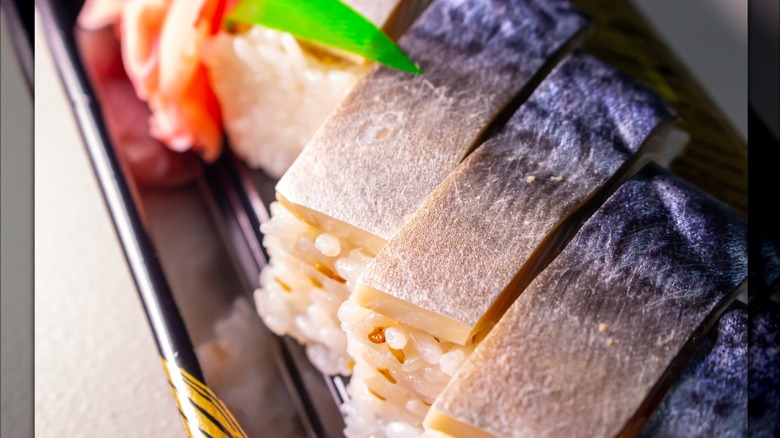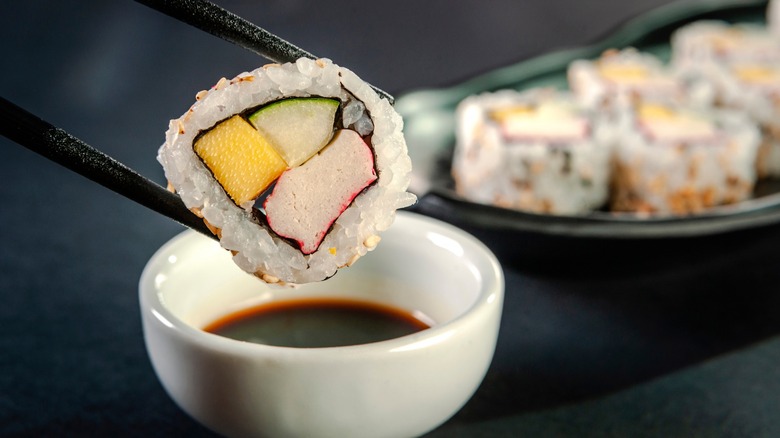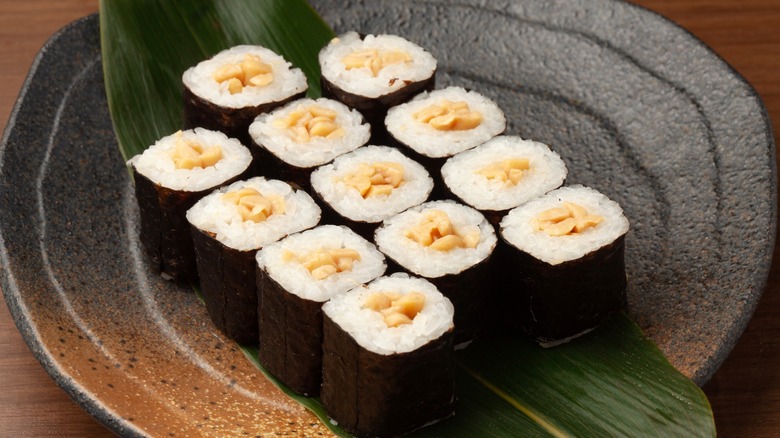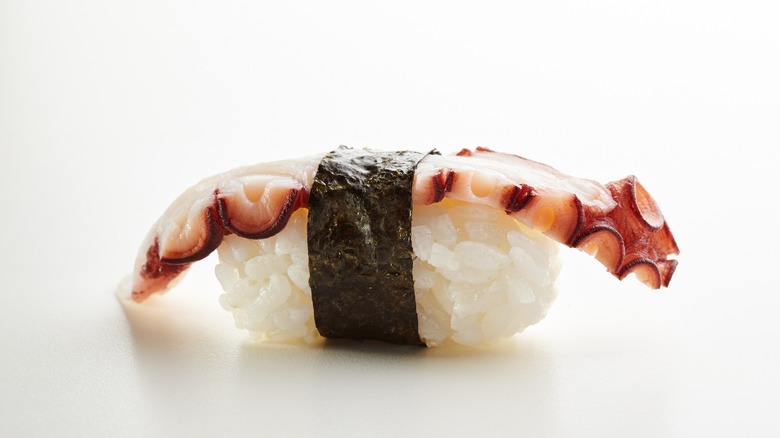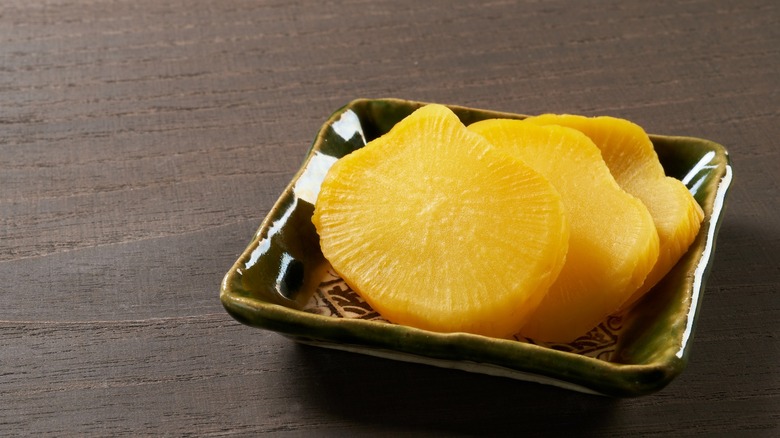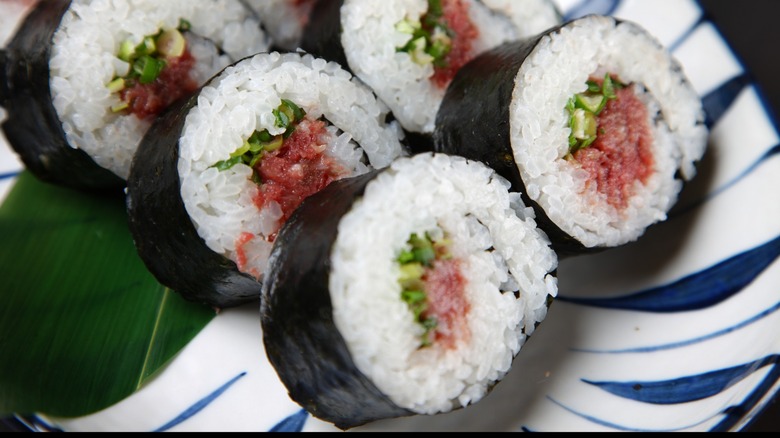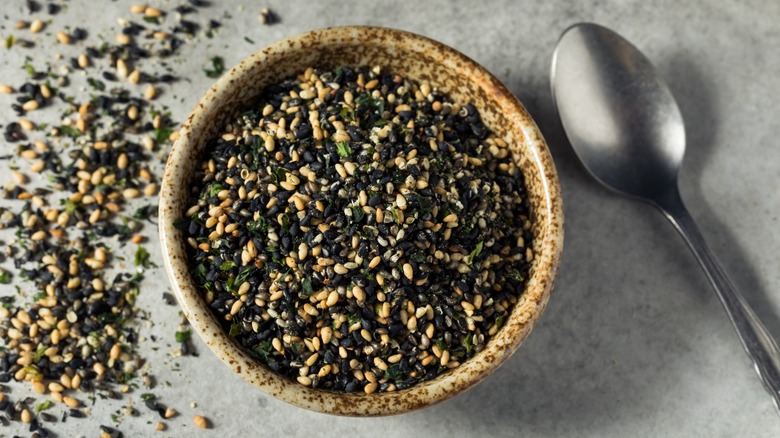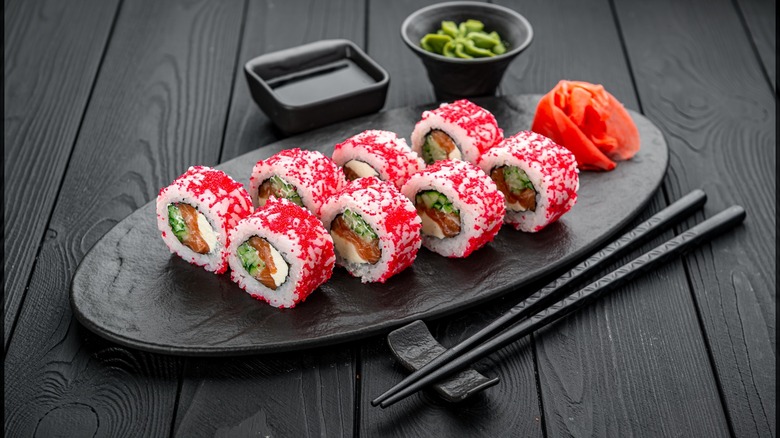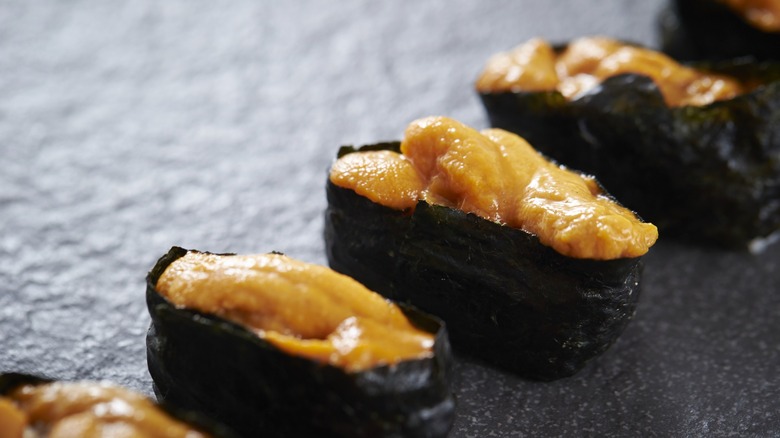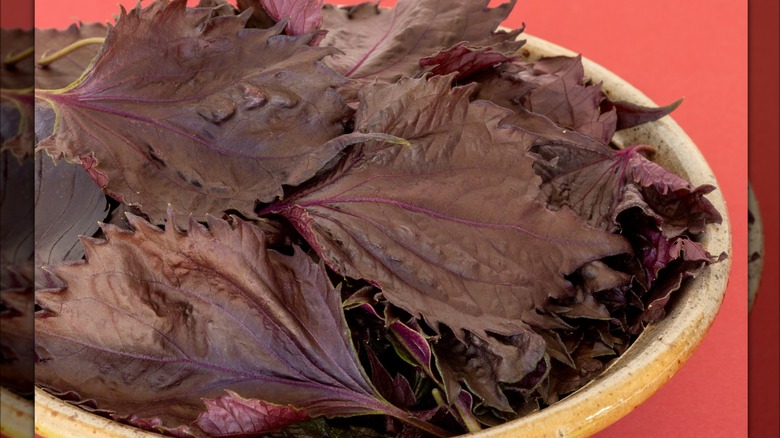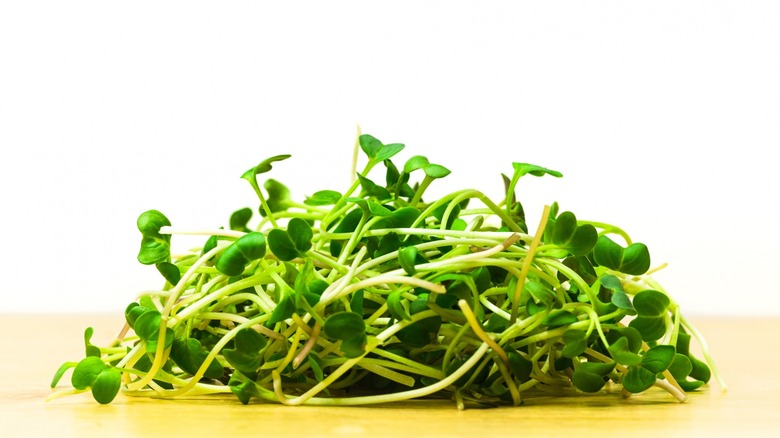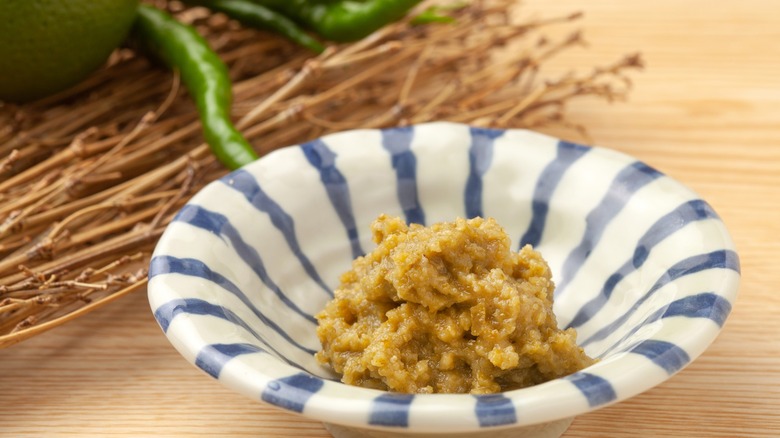14 Ingredients That Will Elevate Your Homemade Sushi
Making sushi at home can seem overwhelming, but it's really not so hard once you get the hang of making perfect rice and rolling it all up — remember that you want those bites to remain delicate and airy; too much pressure, and you'll end up with a solid mass. But what if you've mastered your California rolls and cucumber avocado maki? It might just be time to level up, sushi lovers.
Take a spin through the online menu of any higher-end sushi restaurant, and you'll likely see all kinds of things that you've never heard of or ingredients that you'd never think of putting into your next roll. From mango to pickled plums or sea urchins to eel, we have loads of suggestions for you to take your little bites higher. You'll be flavoring your rice like a pro and pickling veggies perfectly before you know it.
Eel
Eel (known as unagi) might not be that uncommon in a sushi restaurant, but it's probably not something that most home cooks are reaching for. But it doesn't have to be that way if you're really looking to upgrade your home sushi experience. Depending on your location, if fresh eel isn't an option, you might find that more and more grocery stores are starting to carry frozen, prepared eel. And before you decide you don't like it without even trying it, remember that unagi is generally served cooked with an absolutely delicious sauce.
Speaking of delicious, you can whip a simple eel sauce up for use on all sorts of Japanese food — and don't despair; the sauce actually doesn't contain any eels. Instead, it's a thick soy sauce, mirin, and sugar condiment that goes well on all sorts of things (but again, it's especially good on unagi), in particular dumplings and beef negimaki (asparagus rolled in thin beef). If you'd like to try unagi sushi, you can go with a simple nigiri presentation or add it to a roll. Cucumber, avocado, tempura shrimp, and tobiko all work very well with eel.
Kombu
If you've ever made your own miso soup or the dashi base, you'll be well acquainted with kombu. Japan is surrounded by water, and because of this, Japanese food makes use of not only seafood and shellfish but also many kinds of vegetation found in the ocean. Kombu is one of the longest-lasting and economical umami staples you should have in your pantry, too. Depending on where you live, you can often find it pickled or fresh, but, for the rest of us, a bag of the deep green, leathery seaweed will work just as well to add a bit of aquatic, umami punch to your sushi.
The easiest way to upgrade your sushi is by adding a slice of dried kombu while your rice is soaking and boiling, either in a pot or a basic rice cooker (more advanced rice cookers don't always have a soak function, which is needed here). Cook as you normally would, removing the softened seaweed before seasoning and mixing the rice. Cooked kombu can be sliced thinly and added to salads if you don't want to waste it — it will retain some flavor and a lot of the nutrients that make it such an important part of Japanese cooking.
Mackerel
Horse mackerel (known as aji) is a popular choice in Japan, not only for taste but because availability makes it rather affordable, too. Unlike most fish used in sushi, aji is often salted, soaked in rice vinegar, and cured (although it can be served raw), giving it a firmer finish and a tangy, briny taste. Take a look at local Asian markets to see if you can pick up some frozen mackerel and save yourself the process of curing it yourself. Take note that vinegar-cured mackerel is called shime saba, so that's what you're looking for, whereas aji refers to just the fish itself.
Once you've got your hands on some, you're nearly ready to serve up some tender, sustainable mackerel sushi. While you can serve it nigiri style with just some grated ginger and green onion on top, the best way to try aji is in a pressed version of sushi called oshizushi. Made by layering your ingredients into a wooden box (an oshibako) and applying pressure, you'll end up with slices of lovely bite-sized rectangular sushi. Generally, the best quality boxes are made from Japanese cypress, but you can pick up a plastic one when you're first starting out.
Mango
Mango sushi isn't often seen in Japan, but it does occasionally appear. Mangoes aren't as available or affordable as many other ingredients you'll often see in Japanese dishes, but the sweet fruit is still much loved. Using a slice of mango in a sushi roll adds sweetness, often making them better served at the end of the meal. However, mangoes also work incredibly well with anything spicy, so you'll often see that combination make an appearance, too. For vegetarian rolls, try mixing mango with carrots, avocado, or cucumber for a lovely, clean finish.
Feeling more adventurous? Mango partners with seafood beautifully, especially crab, salmon, and tempura shrimp. A sprinkle of shiso or toasted sesame, and you're set. Think about using thinly sliced mangoes to decorate the exterior of your inside-out rolls instead of salmon as a colorful alternative for non-fish eaters (perfect for kids, vegetarians, or pregnant individuals). Finally, mango is a terrific base for a smooth, sweet-tangy sauce that can be drizzled on all kinds of sushi. A little rice vinegar and maybe some sesame oil whizzed into mango purée, and you've got yourself a dazzling drizzle to amp up nearly anything.
Natto
Have you ever tried natto? It's one of those ingredients that can be considered an acquired taste by North Americans, but it's much loved in Asia. Starting out with natto sushi might be the way to go, as you can rely on the sushi rice and nori wrapper to take some of the edge off. They are made from soybeans that get fermented until they develop a pretty funky smell and a lot of stickiness. The smell has been described as coffee-like (so far, so good), but as for the stickiness, that might be where people draw the line. Long, sticky mucilaginous strands (yep, you read that right) give some eaters second thoughts. Honestly, our biggest reservation is the sound it makes when you stir it — what might be ASMR to some is gooey squelching to others.
No matter, we can absolutely admit that after having tried it in quite a few forms, we definitely get the appeal. Soybeans are delish, and so is anything fermented, after all. Wrapped in sushi, you'll also forget that it's incredibly good for you because you'll seriously just enjoy the taste. Natto is really easy to find in Asian markets because of its popularity, so search it out if you want to up your flavor game.
Octopus
Like eel, octopus might be one of those ingredients that you want to try but have misgivings about. Both ingredients are pretty uncommon in North American food, depending on your background. Beloved in Spain, Portugal, and Italy, octopus is incredibly tasty. And if you've been eating calamari, you're really only one step away. Still not convinced? On your next outing to a Japanese restaurant, give the takoyaki a try — deep-fried balls of dough stuffed with octopus meat, sprinkled with bonito flakes, seaweed flakes, tangy mayo, and a sweet sauce — it might just change your mind.
For your at-home experience, frozen octopus is getting easier to find. Vacuum-sealed and raw, you will need to decide how you want to proceed. Octopus (tako in Japanese) can be served raw, but you can also lightly boil it before adding it to sushi. However, don't tackle this if you're not a super-experienced home chef. As you might know, octopus can be awfully chewy without proper preparation. Japanese chefs will often massage the meat with salt and bits of daikon radish before gently boiling; this helps tenderize it while also bringing out the delicate flavor. It is possible to find octopus prepared specifically for sushi, generally online, so if you're busting to give it a go with the troublesome prep, fire up that search engine.
Pickled daikon
Daikon radish is used in many parts of Japanese dining, from a fresh root vegetable to the sweet and salty pickled version. When fresh, daikon has a snowy white appearance and is pretty mild with a faint peppery finish, like many other radishes. It can be cooked and mashed like other root vegetables, but these roots shine when they're pickled to make takuan (pickled daikon). Oshinko, also known as pickled Japanese veggies, are quickly pickled, making them easy to whip up whenever needed. Pickled veggies make an appearance in most Japanese meals as a palate cleanser, but also because they're just so good for you.
Pickled daikon most often gets its gorgeous hue from a pinch of turmeric. If you're buying it premade, look for versions that use natural coloring rather than artificial yellow, if possible. Sweet, salty, and with a crisp crunch, try pickled daikon in sushi that has softer ingredients like avocado or anything a little fatty, like tuna, tempura shrimp, or karaage chicken, for contrast.
Pickled plum
Pickled plums are used in many Japanese foods because, well, they're absolutely delightful in a mouth-puckeringly good way, and when placed on a bed of rice, they're rather reminiscent of the Japanese flag. Known as ume, this little fruit (which is actually closer to an apricot than a plum) is rarely eaten raw, but once salted and pickled, they find their way into all sorts of consumables that could use a touch of savory flavor. Pickling them in sugar and alcohol makes a sweet plum liqueur as well, but most often, they get the salt treatment. The addition of shiso leaves (read on for even more info) to pickled ume is a combination that works perfectly in vegetarian sushi because of the savory umami punch.
While you can use ume paste for your sushi rolls, chopping whole pickled plums (once you remove the pits) will give you a better texture and taste. Be aware that these little fruits aren't as sweet as you might expect — in fact, they're incredibly salty and sour — so don't overload your rolls with them on your first try. They work well in a sushi roll that might be considered a palate cleanser between two fattier fish rolls because of the clean taste and finish.
Rice seasoning
Adding a sprinkle of Japanese rice seasoning, known as furikake, can add more flavor and crunch to some of the simpler rolls you might make. Furikake is made from several ingredients, depending on the flavor you buy (or whip up at home), but nearly always has a base of crumbled nori, fish flakes, sesame seeds, and a little sugar and salt. You can find several variations that include bonito flakes (dried, shaved skipjack tuna), dried egg yolk, miso powder, wasabi, dried baby shrimp, shiitake, and even potato flakes.
Made to sprinkle over rice, it's also one of the ingredients we suggest to elevate your roasted vegetables, so it's no surprise that it can be used to add a pinch of flavor to your sushi. It can also be added to the rice while you're seasoning it, sprinkled on your fillings, or used to garnish inside-out rolls. Use it anywhere that could use a little extra bit of umami and color, but don't go overboard — remember that sushi is all about balance, after all.
Roe
Another gorgeous way to add color and flavor to your sushi is roe, specifically flying fish roe. Known as tobiko, these delightful little balls come in a range of colors and flavors, which add another dimension to homemade sushi. You may have tried sushi with fish eggs in the past, possibly from smelt or sturgeon. If you enjoyed those, we urge you to search out tobiko, too. Tobiko has a very small size and fine texture, and it's known for its crisp pop when eaten, much like caviar. Unlike caviar, however, the minuscule size of the eggs (less than one millimeter) and the mild flavor make tobiko better suited to being used as a topping rather than eaten on its own.
However, one of the best parts about tobiko might just be the range of colors and flavors that can be found. Naturally found in orange to gold shades, if you want that extra punch, you can also find bright green (flavored with wasabi), yellow (from yuzu fruit and ginger), or black (colored with squid ink). Looking for red? You can go two ways here, so be sure to read the label before you start popping them in your mouth. Producers of tobiko will generally use either beetroot or chilies to get that shade, giving you two very different flavors.
Sea urchin
While you may have heard of sea urchin, have you ever had it in sushi? Known as uni, this little morsel is usually only used in two types of sushi — nigiri and gunkan. Nigiri, as you likely know, is a mound of rice topped with a slice of seafood and the occasional accompaniment like wasabi or ginger. Gunkan means battleship, and these sweet little rolls are unusual and spectacular. A mound of rice, like nigiri, with a wrapping of nori around the outer edge, gives these rolls a way to contain the upper toppings beautifully while calling to mind the naval ships that they were named for.
If you've tried uni sushi, you may be a fan for life. First, though, let's talk about what you're actually getting when you order uni. It's not just sea urchin, it's actually just one very specific part of a sea urchin. The only edible part, actually. And that would be the reproductive organs. Once you've made your peace with that, we can talk about the taste. It can be described as sweet and a little sticky and should feel firm in the mouth. The best uni will be processed like sashimi-grade tuna, being cleaned and iced right on the boat.
Shiso
Shiso is used in so many Japanese dishes that we'd never frame it as a sushi-only ingredient. But if you're looking to upgrade anything you're whipping up, this should definitely be on your radar. Commonly called perilla or beefsteak plant stateside, shiso is widely used in Asian cooking for flavor but also for its ability to give a gorgeous hue to foods like plum vinegar. Shiso comes in both purple and green varieties; both are widely used in Asia, where green is more palatable, but purple is prized for the color. Depending on where you are, you might be able to grow it if you can't buy it fresh. However, even a sprinkle of dried shiso will do.
The large leaves have a distinctive edge that makes them a lovely decoration on your sushi platter, but they're more than that. Finely chopped, they'll add a freshly herbaceous twist to sushi filling. Shiso and pickled plums have a long history together, so they're a natural pairing. And just like fried sage leaves in Italian cooking, shiso takes the tempura treatment exceptionally well, so go ahead and add some the next time you've got batter and hot oil on the go. When consumed raw, their astringency pairs perfectly with fish, especially fattier types. They make a perfect layer between salted mackerel and rice, too.
Sprouts
Love veggies and want to get even deeper into their lineage? Try adding sprouts to your sushi for a sweet combination of both tenderness and crunch, as well as a major boost of nutrients. Popular in Japanese cooking is daikon radish, from beginning to end. This means you can definitely add daikon sprouts (kaiware daikon) to your next sushi adventure. That peppery finish that you might know from full-grown radish is far less elusive here.
Not only do they add crunch, amped-up nutrition, and spiciness, sprouts are just too freaking cute. Rolling up temaki sushi (those cone-shaped hand rolls) and leaving some beautiful sprouts or frilly shiso poking out the top gives you an above-average grade on your homemade rolls, honey. Cruise to your local farmer's market or grocer and pick up a pack of sprouts that looks fresh and delish — and they don't have to be daikon, either. Try broccoli, mustard, or whatever looks good. Take them home, cut off the sprouts, and give them a rinse when you're ready to roll. If you're lucky, those roots might even grow a second crop for your next sushi night.
Yuzu kosho
This final one might give you pause, as it's not incredibly well-known over here. But hear us out — it's definitely worth your time, just for the sake of your tastebuds. Yuzu is probably something you know if you're acquainted with Japanese food. A small citrus fruit, much like a floral lemon and grapefruit cross, yuzu has made its way to North America slowly and steadily. Yuzu kosho is a condiment that combines that fragrant little fruit with chili and the magic of fermentation to make something out of this world. This fermented Japanese ingredient can elevate almost any dish, just based on umami power alone. Salty, citrusy, and just spicy enough, we honestly think you're going to love it.
It might not be as easy to find as other Japanese condiments, but we beseech you to keep an eye out for this funky paste. If you can't find it, you can add a dash of hot sauce to ponzu (yuzu juice and fermented soy sauce) for something pretty close. If you can get some fresh yuzu fruit, you can also try making it at home — plan ahead, as you'll need at least a week for the fermentation process.
